Research: Factors Affecting Customer Satisfaction at Fado.vn
VerifiedAdded on 2022/01/21
|65
|14019
|340
Thesis and Dissertation
AI Summary
This thesis investigates the factors affecting customer satisfaction with the e-commerce website Fado.vn in Vietnam. The research, conducted by Le Nhat Duy, utilizes a quantitative approach, collecting data from 248 respondents. The study employs a four-step process: Scale test, Exploratory Factor Analysis (EFA), Confirmatory Factor Analysis (CFA), and Structural Equation Modelling (SEM) to analyze the data. The findings reveal that five independent variables—Tangibility, Assurance, Empathy, Responsiveness, and Reliability—positively correlate with customer satisfaction. The thesis includes an introduction outlining the research's rationale, objectives, scope, methodology, and ethical considerations. A comprehensive literature review covers customer satisfaction, service quality, and their relationship to customer loyalty. The methodology section details the research approach, methods, and design, while the data analysis chapter presents the scale test, EFA, CFA, and SEM results. The conclusion provides recommendations for improving customer satisfaction and overall business performance for e-commerce platforms. The study utilizes IBM SPSS and IBM AMOS software for data analysis, providing valuable insights for e-retailers seeking to enhance customer satisfaction and loyalty.

Paraphrase This Document
Need a fresh take? Get an instant paraphrase of this document with our AI Paraphraser
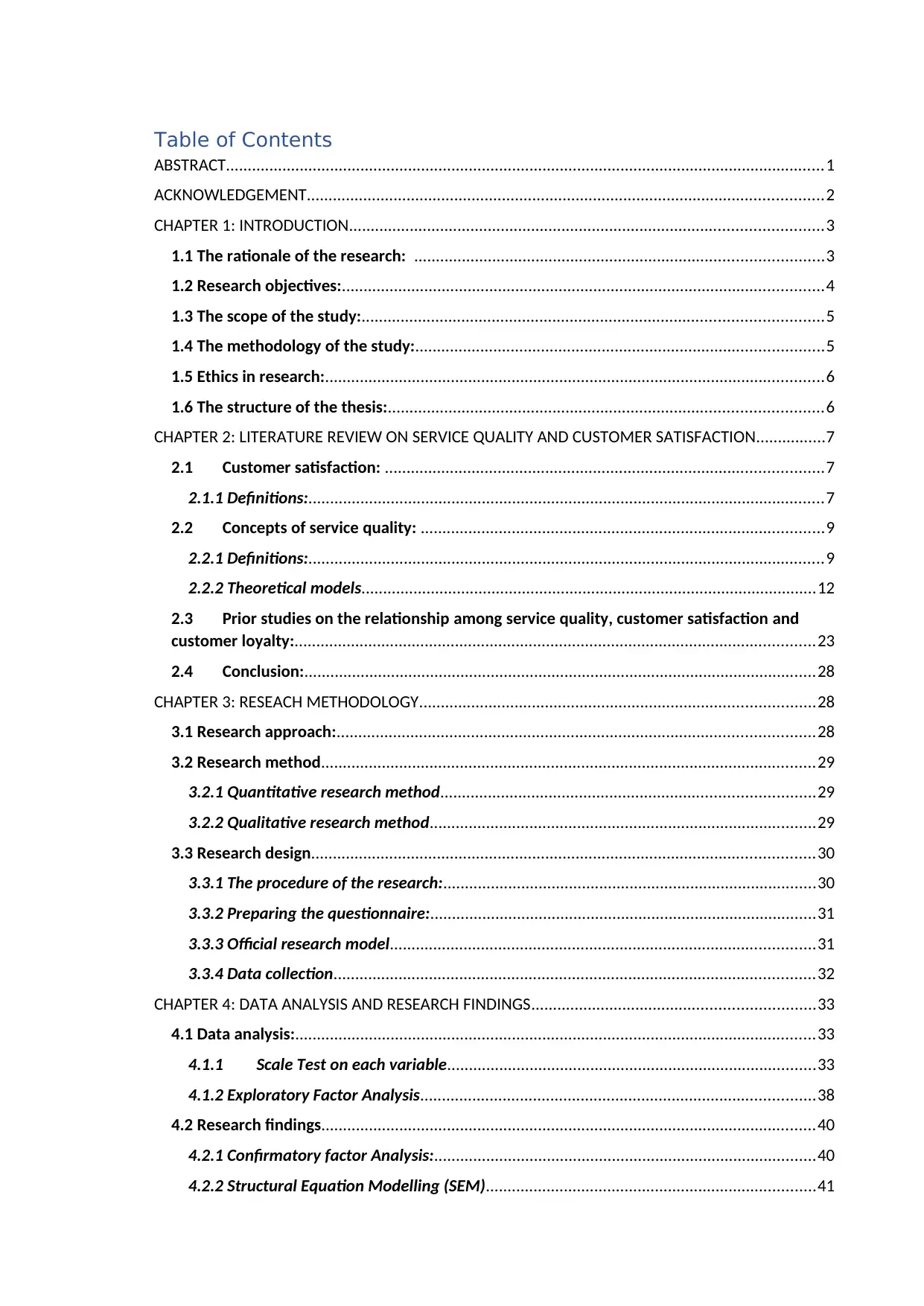
Table of Contents
ABSTRACT..........................................................................................................................................1
ACKNOWLEDGEMENT.......................................................................................................................2
CHAPTER 1: INTRODUCTION.............................................................................................................3
1.1 The rationale of the research: ..............................................................................................3
1.2 Research objectives:...............................................................................................................4
1.3 The scope of the study:..........................................................................................................5
1.4 The methodology of the study:..............................................................................................5
1.5 Ethics in research:...................................................................................................................6
1.6 The structure of the thesis:....................................................................................................6
CHAPTER 2: LITERATURE REVIEW ON SERVICE QUALITY AND CUSTOMER SATISFACTION................7
2.1 Customer satisfaction: .....................................................................................................7
2.1.1 Definitions:.......................................................................................................................7
2.2 Concepts of service quality: .............................................................................................9
2.2.1 Definitions:.......................................................................................................................9
2.2.2 Theoretical models.........................................................................................................12
2.3 Prior studies on the relationship among service quality, customer satisfaction and
customer loyalty:........................................................................................................................23
2.4 Conclusion:......................................................................................................................28
CHAPTER 3: RESEACH METHODOLOGY...........................................................................................28
3.1 Research approach:..............................................................................................................28
3.2 Research method..................................................................................................................29
3.2.1 Quantitative research method......................................................................................29
3.2.2 Qualitative research method.........................................................................................29
3.3 Research design....................................................................................................................30
3.3.1 The procedure of the research:......................................................................................30
3.3.2 Preparing the questionnaire:.........................................................................................31
3.3.3 Official research model..................................................................................................31
3.3.4 Data collection...............................................................................................................32
CHAPTER 4: DATA ANALYSIS AND RESEARCH FINDINGS.................................................................33
4.1 Data analysis:........................................................................................................................33
4.1.1 Scale Test on each variable.....................................................................................33
4.1.2 Exploratory Factor Analysis...........................................................................................38
4.2 Research findings..................................................................................................................40
4.2.1 Confirmatory factor Analysis:........................................................................................40
4.2.2 Structural Equation Modelling (SEM)............................................................................41
ABSTRACT..........................................................................................................................................1
ACKNOWLEDGEMENT.......................................................................................................................2
CHAPTER 1: INTRODUCTION.............................................................................................................3
1.1 The rationale of the research: ..............................................................................................3
1.2 Research objectives:...............................................................................................................4
1.3 The scope of the study:..........................................................................................................5
1.4 The methodology of the study:..............................................................................................5
1.5 Ethics in research:...................................................................................................................6
1.6 The structure of the thesis:....................................................................................................6
CHAPTER 2: LITERATURE REVIEW ON SERVICE QUALITY AND CUSTOMER SATISFACTION................7
2.1 Customer satisfaction: .....................................................................................................7
2.1.1 Definitions:.......................................................................................................................7
2.2 Concepts of service quality: .............................................................................................9
2.2.1 Definitions:.......................................................................................................................9
2.2.2 Theoretical models.........................................................................................................12
2.3 Prior studies on the relationship among service quality, customer satisfaction and
customer loyalty:........................................................................................................................23
2.4 Conclusion:......................................................................................................................28
CHAPTER 3: RESEACH METHODOLOGY...........................................................................................28
3.1 Research approach:..............................................................................................................28
3.2 Research method..................................................................................................................29
3.2.1 Quantitative research method......................................................................................29
3.2.2 Qualitative research method.........................................................................................29
3.3 Research design....................................................................................................................30
3.3.1 The procedure of the research:......................................................................................30
3.3.2 Preparing the questionnaire:.........................................................................................31
3.3.3 Official research model..................................................................................................31
3.3.4 Data collection...............................................................................................................32
CHAPTER 4: DATA ANALYSIS AND RESEARCH FINDINGS.................................................................33
4.1 Data analysis:........................................................................................................................33
4.1.1 Scale Test on each variable.....................................................................................33
4.1.2 Exploratory Factor Analysis...........................................................................................38
4.2 Research findings..................................................................................................................40
4.2.1 Confirmatory factor Analysis:........................................................................................40
4.2.2 Structural Equation Modelling (SEM)............................................................................41
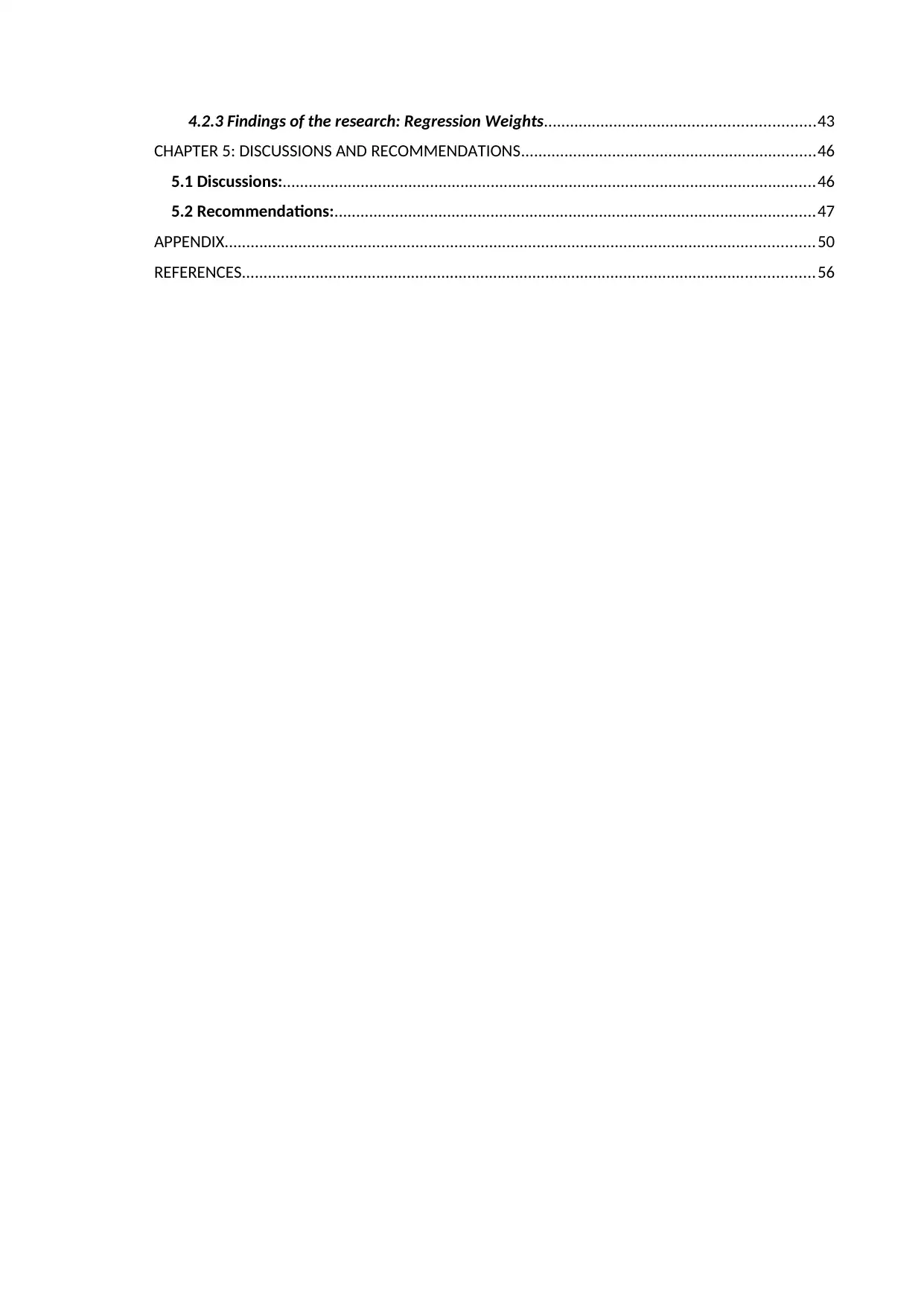
4.2.3 Findings of the research: Regression Weights..............................................................43
CHAPTER 5: DISCUSSIONS AND RECOMMENDATIONS....................................................................46
5.1 Discussions:...........................................................................................................................46
5.2 Recommendations:...............................................................................................................47
APPENDIX........................................................................................................................................50
REFERENCES....................................................................................................................................56
CHAPTER 5: DISCUSSIONS AND RECOMMENDATIONS....................................................................46
5.1 Discussions:...........................................................................................................................46
5.2 Recommendations:...............................................................................................................47
APPENDIX........................................................................................................................................50
REFERENCES....................................................................................................................................56
⊘ This is a preview!⊘
Do you want full access?
Subscribe today to unlock all pages.

Trusted by 1+ million students worldwide
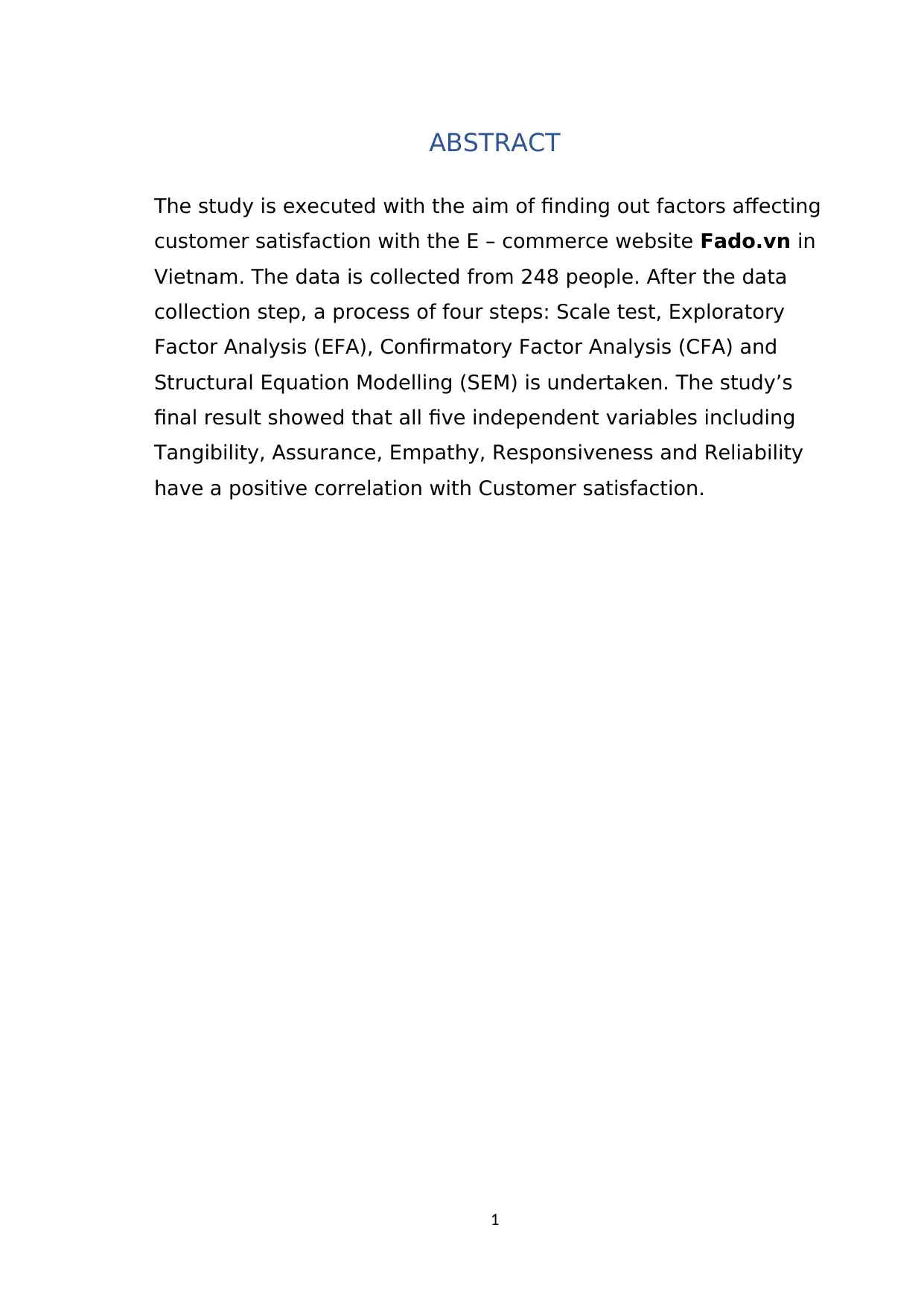
ABSTRACT
The study is executed with the aim of finding out factors affecting
customer satisfaction with the E – commerce website Fado.vn in
Vietnam. The data is collected from 248 people. After the data
collection step, a process of four steps: Scale test, Exploratory
Factor Analysis (EFA), Confirmatory Factor Analysis (CFA) and
Structural Equation Modelling (SEM) is undertaken. The study’s
final result showed that all five independent variables including
Tangibility, Assurance, Empathy, Responsiveness and Reliability
have a positive correlation with Customer satisfaction.
1
The study is executed with the aim of finding out factors affecting
customer satisfaction with the E – commerce website Fado.vn in
Vietnam. The data is collected from 248 people. After the data
collection step, a process of four steps: Scale test, Exploratory
Factor Analysis (EFA), Confirmatory Factor Analysis (CFA) and
Structural Equation Modelling (SEM) is undertaken. The study’s
final result showed that all five independent variables including
Tangibility, Assurance, Empathy, Responsiveness and Reliability
have a positive correlation with Customer satisfaction.
1
Paraphrase This Document
Need a fresh take? Get an instant paraphrase of this document with our AI Paraphraser
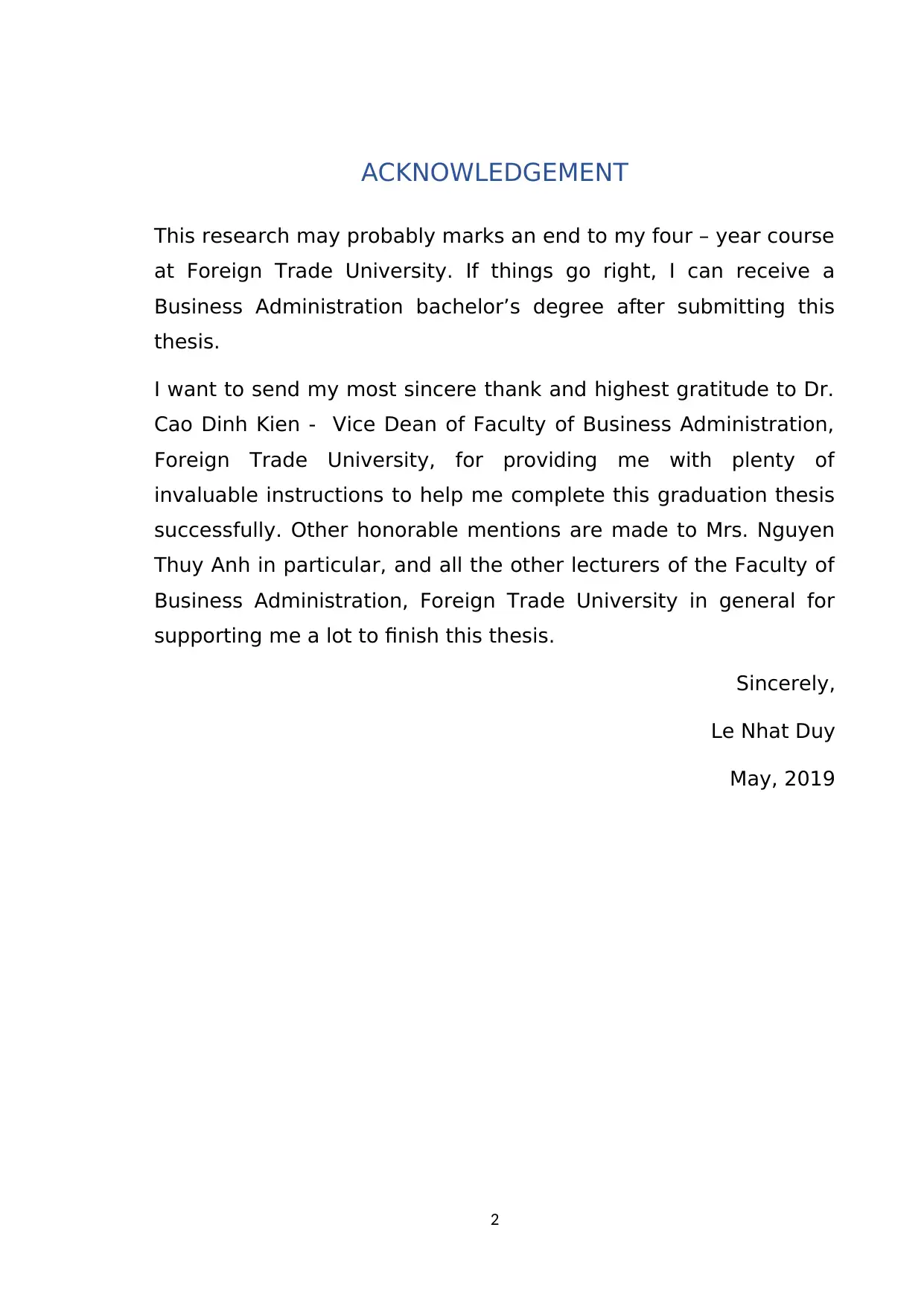
ACKNOWLEDGEMENT
This research may probably marks an end to my four – year course
at Foreign Trade University. If things go right, I can receive a
Business Administration bachelor’s degree after submitting this
thesis.
I want to send my most sincere thank and highest gratitude to Dr.
Cao Dinh Kien - Vice Dean of Faculty of Business Administration,
Foreign Trade University, for providing me with plenty of
invaluable instructions to help me complete this graduation thesis
successfully. Other honorable mentions are made to Mrs. Nguyen
Thuy Anh in particular, and all the other lecturers of the Faculty of
Business Administration, Foreign Trade University in general for
supporting me a lot to finish this thesis.
Sincerely,
Le Nhat Duy
May, 2019
2
This research may probably marks an end to my four – year course
at Foreign Trade University. If things go right, I can receive a
Business Administration bachelor’s degree after submitting this
thesis.
I want to send my most sincere thank and highest gratitude to Dr.
Cao Dinh Kien - Vice Dean of Faculty of Business Administration,
Foreign Trade University, for providing me with plenty of
invaluable instructions to help me complete this graduation thesis
successfully. Other honorable mentions are made to Mrs. Nguyen
Thuy Anh in particular, and all the other lecturers of the Faculty of
Business Administration, Foreign Trade University in general for
supporting me a lot to finish this thesis.
Sincerely,
Le Nhat Duy
May, 2019
2
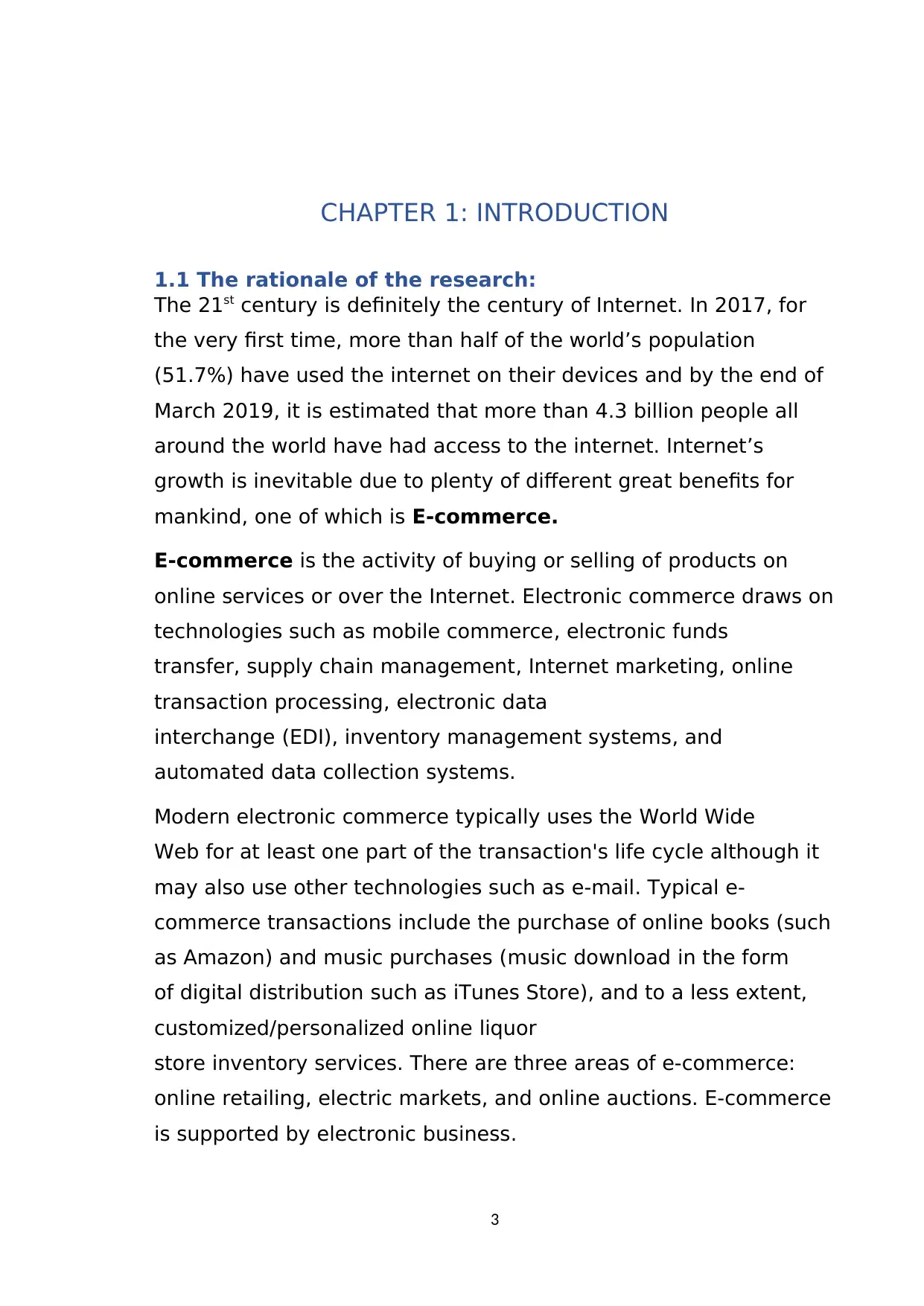
CHAPTER 1: INTRODUCTION
1.1 The rationale of the research:
The 21st century is definitely the century of Internet. In 2017, for
the very first time, more than half of the world’s population
(51.7%) have used the internet on their devices and by the end of
March 2019, it is estimated that more than 4.3 billion people all
around the world have had access to the internet. Internet’s
growth is inevitable due to plenty of different great benefits for
mankind, one of which is E-commerce.
E-commerce is the activity of buying or selling of products on
online services or over the Internet. Electronic commerce draws on
technologies such as mobile commerce, electronic funds
transfer, supply chain management, Internet marketing, online
transaction processing, electronic data
interchange (EDI), inventory management systems, and
automated data collection systems.
Modern electronic commerce typically uses the World Wide
Web for at least one part of the transaction's life cycle although it
may also use other technologies such as e-mail. Typical e-
commerce transactions include the purchase of online books (such
as Amazon) and music purchases (music download in the form
of digital distribution such as iTunes Store), and to a less extent,
customized/personalized online liquor
store inventory services. There are three areas of e-commerce:
online retailing, electric markets, and online auctions. E-commerce
is supported by electronic business.
3
1.1 The rationale of the research:
The 21st century is definitely the century of Internet. In 2017, for
the very first time, more than half of the world’s population
(51.7%) have used the internet on their devices and by the end of
March 2019, it is estimated that more than 4.3 billion people all
around the world have had access to the internet. Internet’s
growth is inevitable due to plenty of different great benefits for
mankind, one of which is E-commerce.
E-commerce is the activity of buying or selling of products on
online services or over the Internet. Electronic commerce draws on
technologies such as mobile commerce, electronic funds
transfer, supply chain management, Internet marketing, online
transaction processing, electronic data
interchange (EDI), inventory management systems, and
automated data collection systems.
Modern electronic commerce typically uses the World Wide
Web for at least one part of the transaction's life cycle although it
may also use other technologies such as e-mail. Typical e-
commerce transactions include the purchase of online books (such
as Amazon) and music purchases (music download in the form
of digital distribution such as iTunes Store), and to a less extent,
customized/personalized online liquor
store inventory services. There are three areas of e-commerce:
online retailing, electric markets, and online auctions. E-commerce
is supported by electronic business.
3
⊘ This is a preview!⊘
Do you want full access?
Subscribe today to unlock all pages.

Trusted by 1+ million students worldwide
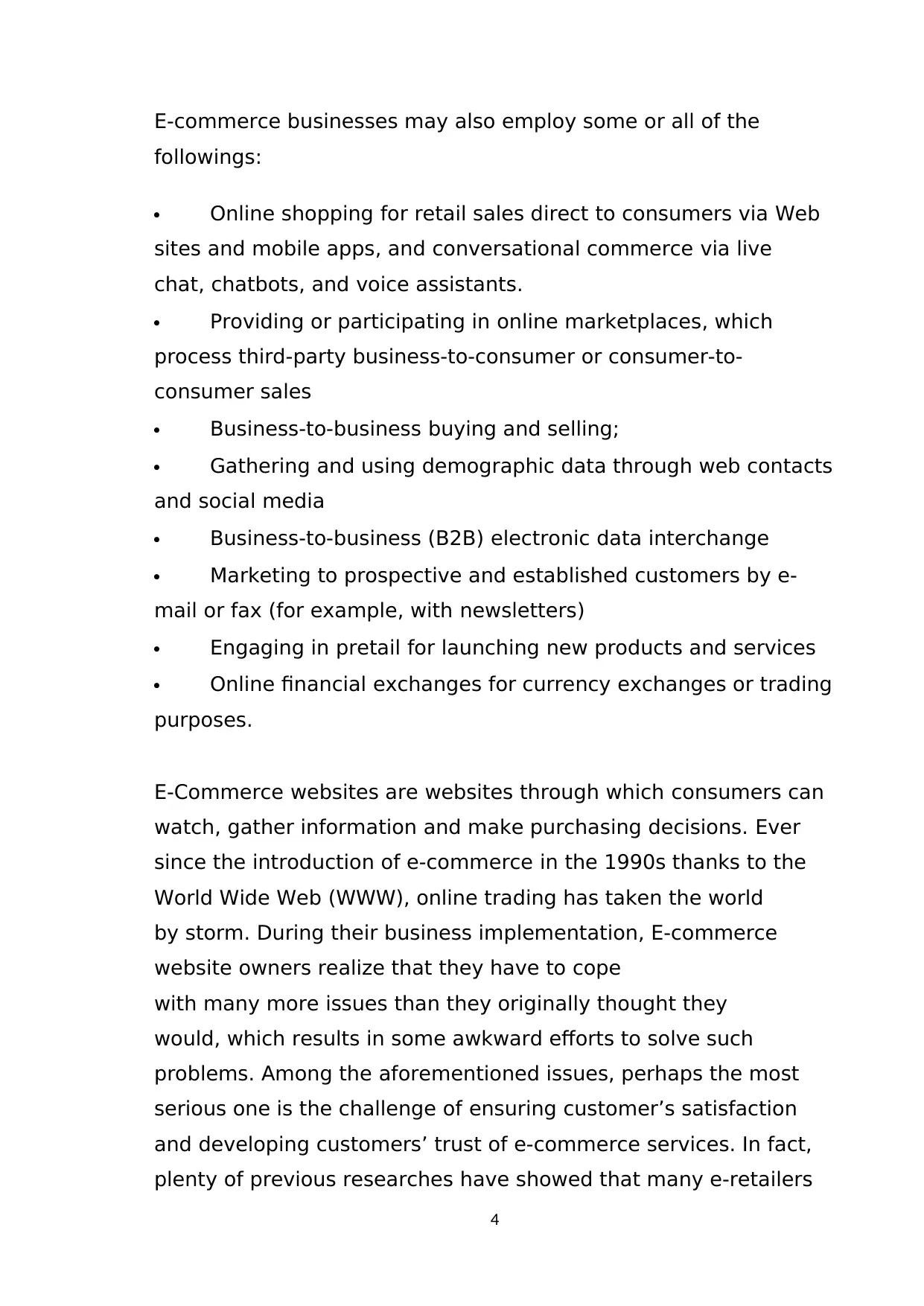
E-commerce businesses may also employ some or all of the
followings:
Online shopping for retail sales direct to consumers via Web
sites and mobile apps, and conversational commerce via live
chat, chatbots, and voice assistants.
Providing or participating in online marketplaces, which
process third-party business-to-consumer or consumer-to-
consumer sales
Business-to-business buying and selling;
Gathering and using demographic data through web contacts
and social media
Business-to-business (B2B) electronic data interchange
Marketing to prospective and established customers by e-
mail or fax (for example, with newsletters)
Engaging in pretail for launching new products and services
Online financial exchanges for currency exchanges or trading
purposes.
E-Commerce websites are websites through which consumers can
watch, gather information and make purchasing decisions. Ever
since the introduction of e-commerce in the 1990s thanks to the
World Wide Web (WWW), online trading has taken the world
by storm. During their business implementation, E-commerce
website owners realize that they have to cope
with many more issues than they originally thought they
would, which results in some awkward efforts to solve such
problems. Among the aforementioned issues, perhaps the most
serious one is the challenge of ensuring customer’s satisfaction
and developing customers’ trust of e-commerce services. In fact,
plenty of previous researches have showed that many e-retailers
4
followings:
Online shopping for retail sales direct to consumers via Web
sites and mobile apps, and conversational commerce via live
chat, chatbots, and voice assistants.
Providing or participating in online marketplaces, which
process third-party business-to-consumer or consumer-to-
consumer sales
Business-to-business buying and selling;
Gathering and using demographic data through web contacts
and social media
Business-to-business (B2B) electronic data interchange
Marketing to prospective and established customers by e-
mail or fax (for example, with newsletters)
Engaging in pretail for launching new products and services
Online financial exchanges for currency exchanges or trading
purposes.
E-Commerce websites are websites through which consumers can
watch, gather information and make purchasing decisions. Ever
since the introduction of e-commerce in the 1990s thanks to the
World Wide Web (WWW), online trading has taken the world
by storm. During their business implementation, E-commerce
website owners realize that they have to cope
with many more issues than they originally thought they
would, which results in some awkward efforts to solve such
problems. Among the aforementioned issues, perhaps the most
serious one is the challenge of ensuring customer’s satisfaction
and developing customers’ trust of e-commerce services. In fact,
plenty of previous researches have showed that many e-retailers
4
Paraphrase This Document
Need a fresh take? Get an instant paraphrase of this document with our AI Paraphraser
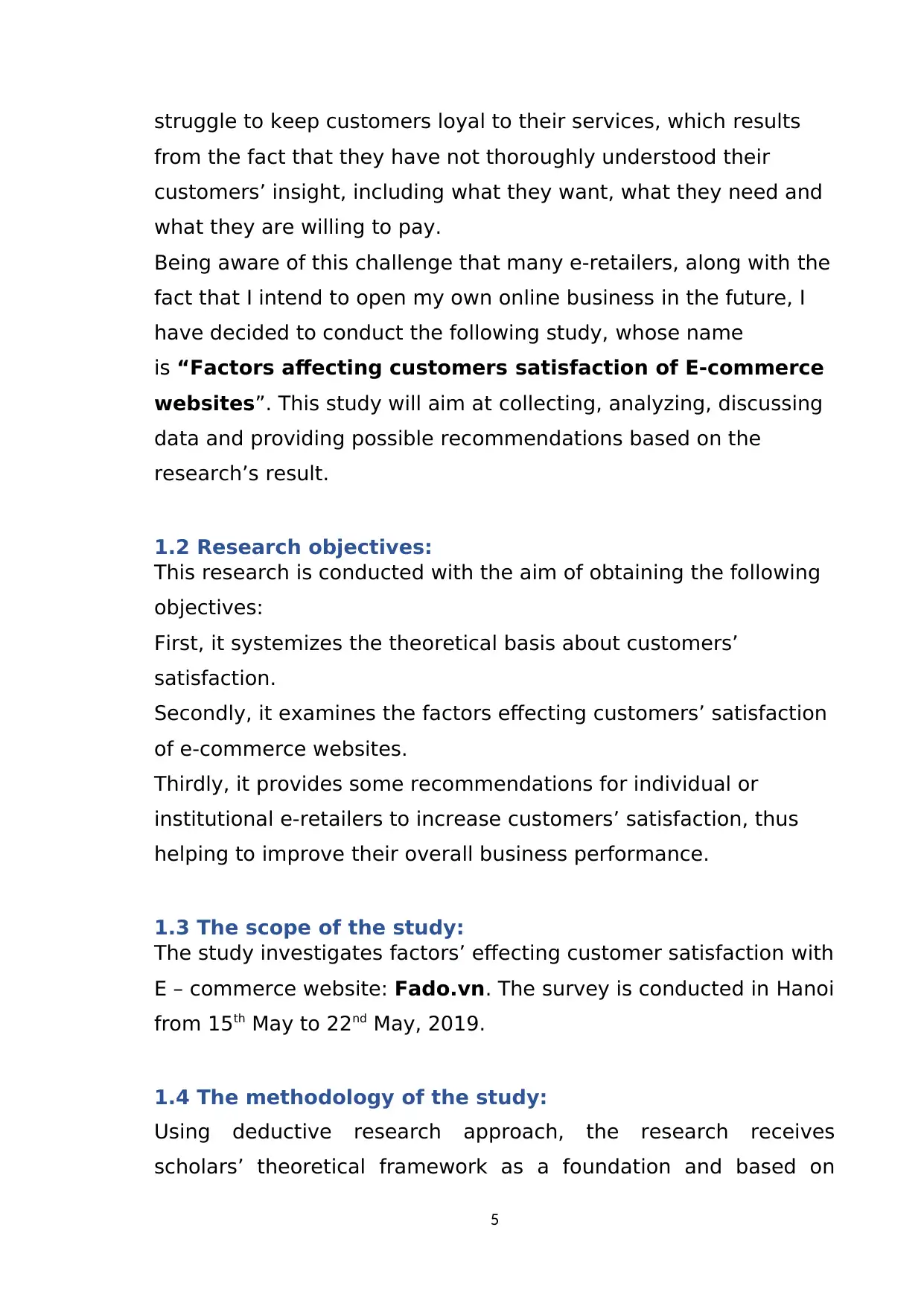
struggle to keep customers loyal to their services, which results
from the fact that they have not thoroughly understood their
customers’ insight, including what they want, what they need and
what they are willing to pay.
Being aware of this challenge that many e-retailers, along with the
fact that I intend to open my own online business in the future, I
have decided to conduct the following study, whose name
is “Factors affecting customers satisfaction of E-commerce
websites”. This study will aim at collecting, analyzing, discussing
data and providing possible recommendations based on the
research’s result.
1.2 Research objectives:
This research is conducted with the aim of obtaining the following
objectives:
First, it systemizes the theoretical basis about customers’
satisfaction.
Secondly, it examines the factors effecting customers’ satisfaction
of e-commerce websites.
Thirdly, it provides some recommendations for individual or
institutional e-retailers to increase customers’ satisfaction, thus
helping to improve their overall business performance.
1.3 The scope of the study:
The study investigates factors’ effecting customer satisfaction with
E – commerce website: Fado.vn. The survey is conducted in Hanoi
from 15th May to 22nd May, 2019.
1.4 The methodology of the study:
Using deductive research approach, the research receives
scholars’ theoretical framework as a foundation and based on
5
from the fact that they have not thoroughly understood their
customers’ insight, including what they want, what they need and
what they are willing to pay.
Being aware of this challenge that many e-retailers, along with the
fact that I intend to open my own online business in the future, I
have decided to conduct the following study, whose name
is “Factors affecting customers satisfaction of E-commerce
websites”. This study will aim at collecting, analyzing, discussing
data and providing possible recommendations based on the
research’s result.
1.2 Research objectives:
This research is conducted with the aim of obtaining the following
objectives:
First, it systemizes the theoretical basis about customers’
satisfaction.
Secondly, it examines the factors effecting customers’ satisfaction
of e-commerce websites.
Thirdly, it provides some recommendations for individual or
institutional e-retailers to increase customers’ satisfaction, thus
helping to improve their overall business performance.
1.3 The scope of the study:
The study investigates factors’ effecting customer satisfaction with
E – commerce website: Fado.vn. The survey is conducted in Hanoi
from 15th May to 22nd May, 2019.
1.4 The methodology of the study:
Using deductive research approach, the research receives
scholars’ theoretical framework as a foundation and based on
5
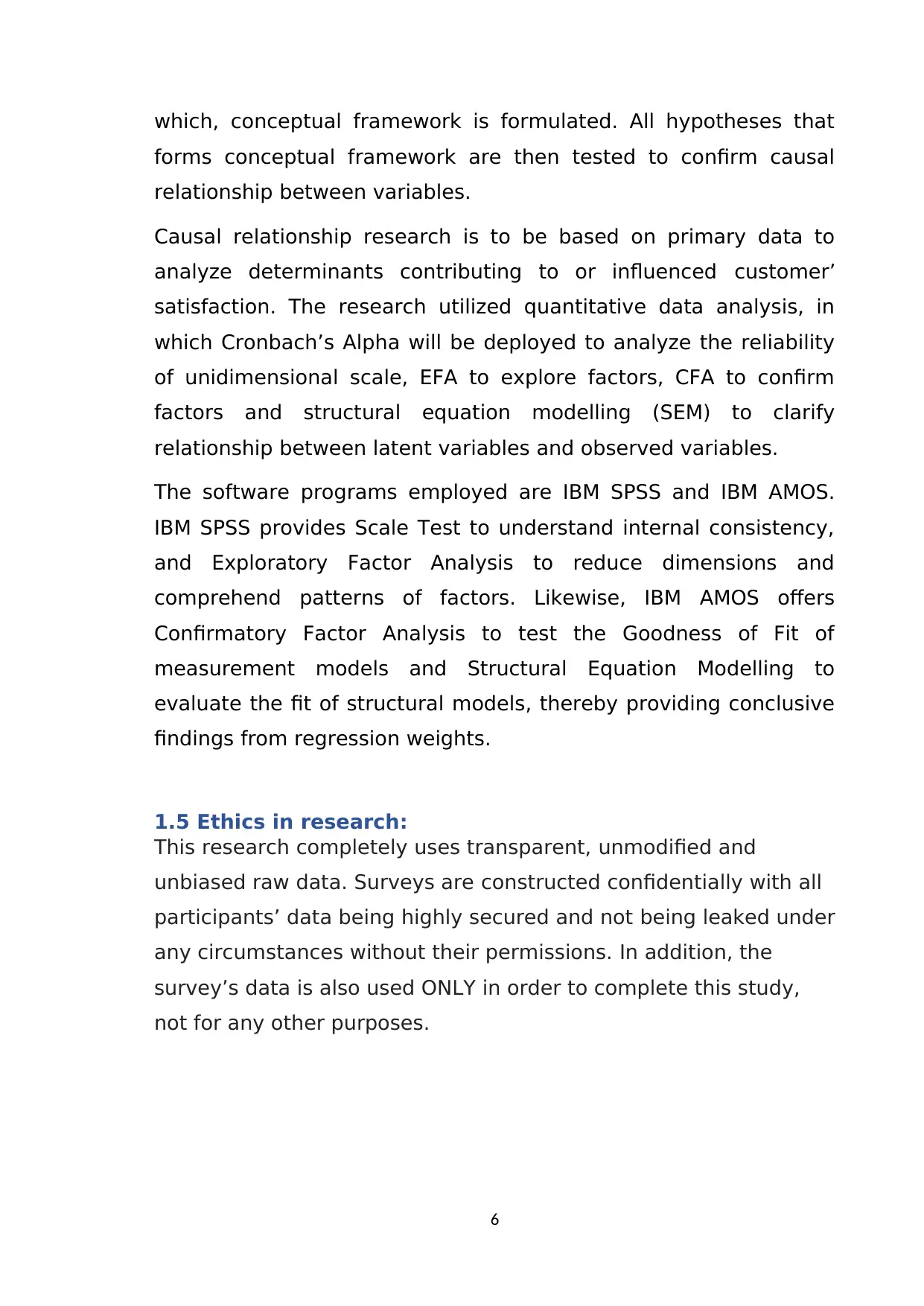
which, conceptual framework is formulated. All hypotheses that
forms conceptual framework are then tested to confirm causal
relationship between variables.
Causal relationship research is to be based on primary data to
analyze determinants contributing to or influenced customer’
satisfaction. The research utilized quantitative data analysis, in
which Cronbach’s Alpha will be deployed to analyze the reliability
of unidimensional scale, EFA to explore factors, CFA to confirm
factors and structural equation modelling (SEM) to clarify
relationship between latent variables and observed variables.
The software programs employed are IBM SPSS and IBM AMOS.
IBM SPSS provides Scale Test to understand internal consistency,
and Exploratory Factor Analysis to reduce dimensions and
comprehend patterns of factors. Likewise, IBM AMOS offers
Confirmatory Factor Analysis to test the Goodness of Fit of
measurement models and Structural Equation Modelling to
evaluate the fit of structural models, thereby providing conclusive
findings from regression weights.
1.5 Ethics in research:
This research completely uses transparent, unmodified and
unbiased raw data. Surveys are constructed confidentially with all
participants’ data being highly secured and not being leaked under
any circumstances without their permissions. In addition, the
survey’s data is also used ONLY in order to complete this study,
not for any other purposes.
6
forms conceptual framework are then tested to confirm causal
relationship between variables.
Causal relationship research is to be based on primary data to
analyze determinants contributing to or influenced customer’
satisfaction. The research utilized quantitative data analysis, in
which Cronbach’s Alpha will be deployed to analyze the reliability
of unidimensional scale, EFA to explore factors, CFA to confirm
factors and structural equation modelling (SEM) to clarify
relationship between latent variables and observed variables.
The software programs employed are IBM SPSS and IBM AMOS.
IBM SPSS provides Scale Test to understand internal consistency,
and Exploratory Factor Analysis to reduce dimensions and
comprehend patterns of factors. Likewise, IBM AMOS offers
Confirmatory Factor Analysis to test the Goodness of Fit of
measurement models and Structural Equation Modelling to
evaluate the fit of structural models, thereby providing conclusive
findings from regression weights.
1.5 Ethics in research:
This research completely uses transparent, unmodified and
unbiased raw data. Surveys are constructed confidentially with all
participants’ data being highly secured and not being leaked under
any circumstances without their permissions. In addition, the
survey’s data is also used ONLY in order to complete this study,
not for any other purposes.
6
⊘ This is a preview!⊘
Do you want full access?
Subscribe today to unlock all pages.

Trusted by 1+ million students worldwide
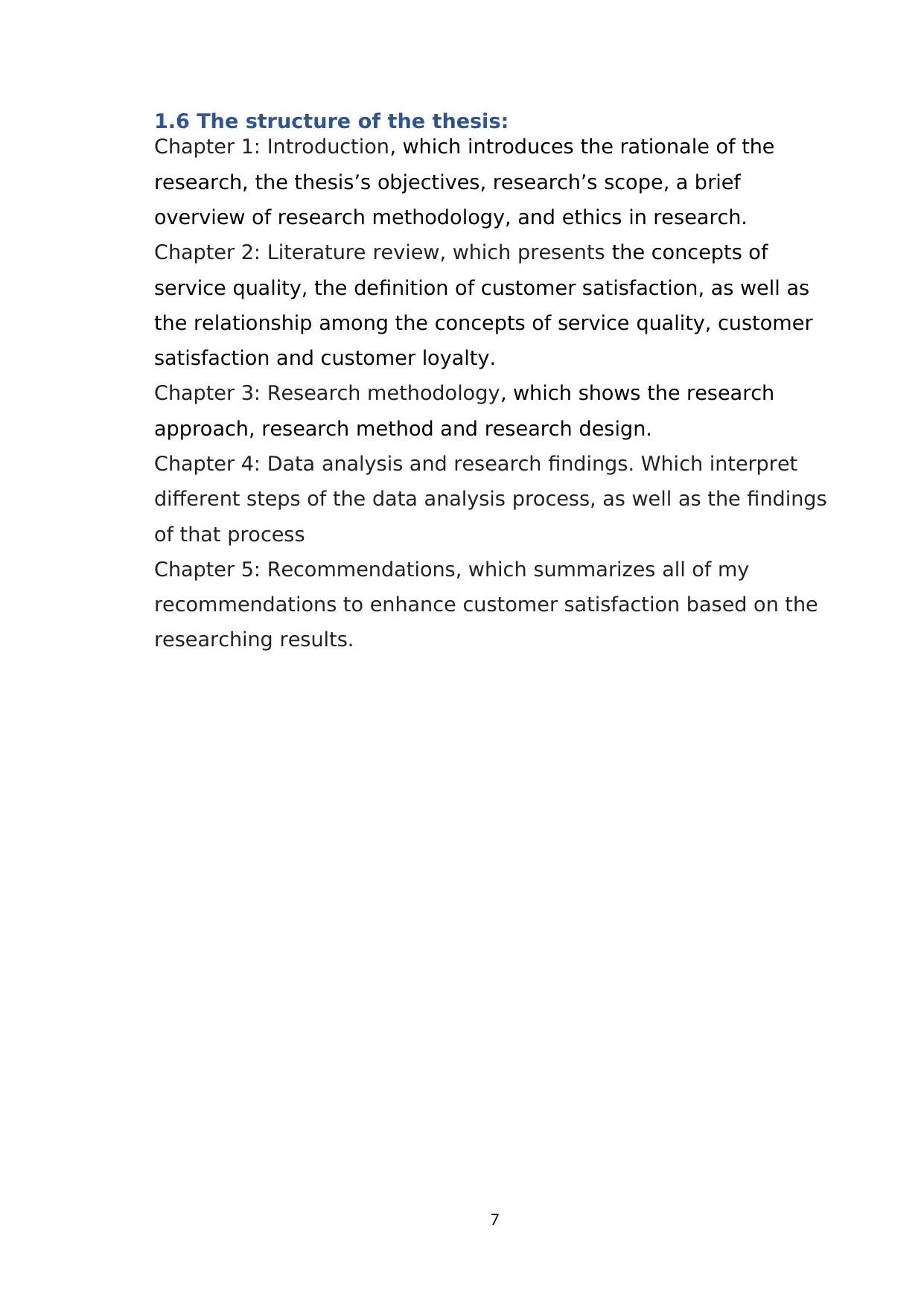
1.6 The structure of the thesis:
Chapter 1: Introduction, which introduces the rationale of the
research, the thesis’s objectives, research’s scope, a brief
overview of research methodology, and ethics in research.
Chapter 2: Literature review, which presents the concepts of
service quality, the definition of customer satisfaction, as well as
the relationship among the concepts of service quality, customer
satisfaction and customer loyalty.
Chapter 3: Research methodology, which shows the research
approach, research method and research design.
Chapter 4: Data analysis and research findings. Which interpret
different steps of the data analysis process, as well as the findings
of that process
Chapter 5: Recommendations, which summarizes all of my
recommendations to enhance customer satisfaction based on the
researching results.
7
Chapter 1: Introduction, which introduces the rationale of the
research, the thesis’s objectives, research’s scope, a brief
overview of research methodology, and ethics in research.
Chapter 2: Literature review, which presents the concepts of
service quality, the definition of customer satisfaction, as well as
the relationship among the concepts of service quality, customer
satisfaction and customer loyalty.
Chapter 3: Research methodology, which shows the research
approach, research method and research design.
Chapter 4: Data analysis and research findings. Which interpret
different steps of the data analysis process, as well as the findings
of that process
Chapter 5: Recommendations, which summarizes all of my
recommendations to enhance customer satisfaction based on the
researching results.
7
Paraphrase This Document
Need a fresh take? Get an instant paraphrase of this document with our AI Paraphraser
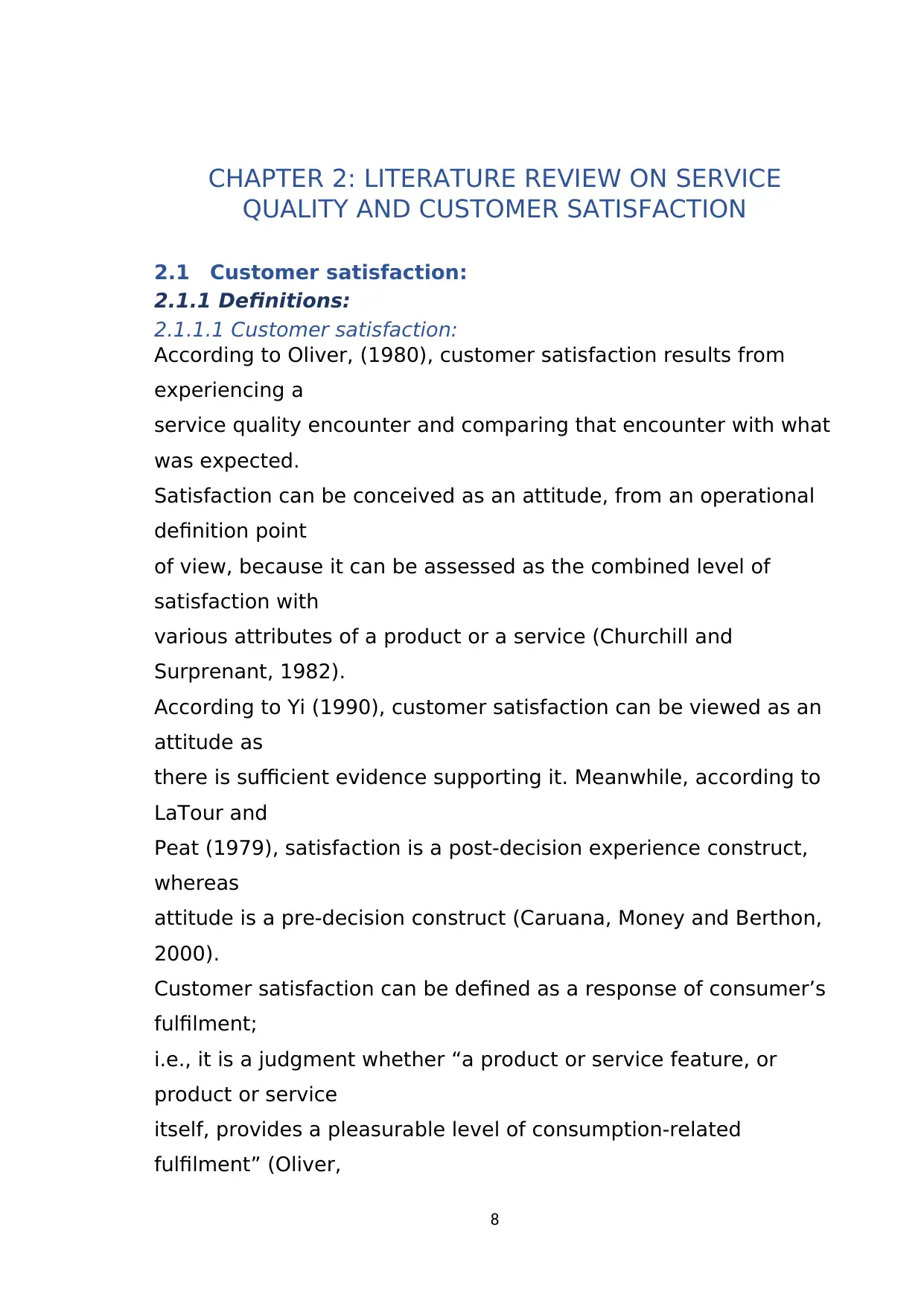
CHAPTER 2: LITERATURE REVIEW ON SERVICE
QUALITY AND CUSTOMER SATISFACTION
2.1 Customer satisfaction:
2.1.1 Definitions:
2.1.1.1 Customer satisfaction:
According to Oliver, (1980), customer satisfaction results from
experiencing a
service quality encounter and comparing that encounter with what
was expected.
Satisfaction can be conceived as an attitude, from an operational
definition point
of view, because it can be assessed as the combined level of
satisfaction with
various attributes of a product or a service (Churchill and
Surprenant, 1982).
According to Yi (1990), customer satisfaction can be viewed as an
attitude as
there is sufficient evidence supporting it. Meanwhile, according to
LaTour and
Peat (1979), satisfaction is a post-decision experience construct,
whereas
attitude is a pre-decision construct (Caruana, Money and Berthon,
2000).
Customer satisfaction can be defined as a response of consumer’s
fulfilment;
i.e., it is a judgment whether “a product or service feature, or
product or service
itself, provides a pleasurable level of consumption-related
fulfilment” (Oliver,
8
QUALITY AND CUSTOMER SATISFACTION
2.1 Customer satisfaction:
2.1.1 Definitions:
2.1.1.1 Customer satisfaction:
According to Oliver, (1980), customer satisfaction results from
experiencing a
service quality encounter and comparing that encounter with what
was expected.
Satisfaction can be conceived as an attitude, from an operational
definition point
of view, because it can be assessed as the combined level of
satisfaction with
various attributes of a product or a service (Churchill and
Surprenant, 1982).
According to Yi (1990), customer satisfaction can be viewed as an
attitude as
there is sufficient evidence supporting it. Meanwhile, according to
LaTour and
Peat (1979), satisfaction is a post-decision experience construct,
whereas
attitude is a pre-decision construct (Caruana, Money and Berthon,
2000).
Customer satisfaction can be defined as a response of consumer’s
fulfilment;
i.e., it is a judgment whether “a product or service feature, or
product or service
itself, provides a pleasurable level of consumption-related
fulfilment” (Oliver,
8
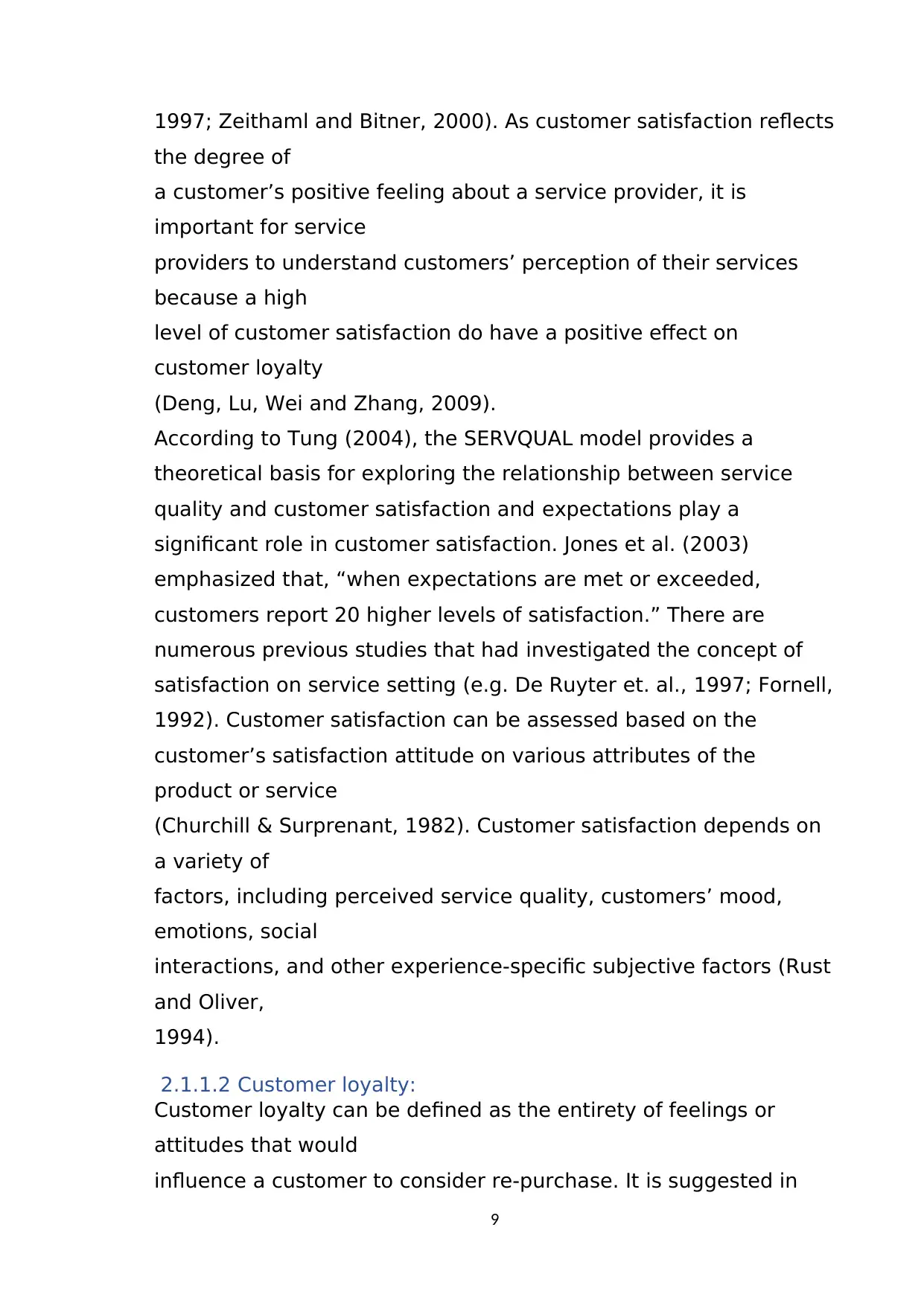
1997; Zeithaml and Bitner, 2000). As customer satisfaction reflects
the degree of
a customer’s positive feeling about a service provider, it is
important for service
providers to understand customers’ perception of their services
because a high
level of customer satisfaction do have a positive effect on
customer loyalty
(Deng, Lu, Wei and Zhang, 2009).
According to Tung (2004), the SERVQUAL model provides a
theoretical basis for exploring the relationship between service
quality and customer satisfaction and expectations play a
significant role in customer satisfaction. Jones et al. (2003)
emphasized that, “when expectations are met or exceeded,
customers report 20 higher levels of satisfaction.” There are
numerous previous studies that had investigated the concept of
satisfaction on service setting (e.g. De Ruyter et. al., 1997; Fornell,
1992). Customer satisfaction can be assessed based on the
customer’s satisfaction attitude on various attributes of the
product or service
(Churchill & Surprenant, 1982). Customer satisfaction depends on
a variety of
factors, including perceived service quality, customers’ mood,
emotions, social
interactions, and other experience-specific subjective factors (Rust
and Oliver,
1994).
2.1.1.2 Customer loyalty:
Customer loyalty can be defined as the entirety of feelings or
attitudes that would
influence a customer to consider re-purchase. It is suggested in
9
the degree of
a customer’s positive feeling about a service provider, it is
important for service
providers to understand customers’ perception of their services
because a high
level of customer satisfaction do have a positive effect on
customer loyalty
(Deng, Lu, Wei and Zhang, 2009).
According to Tung (2004), the SERVQUAL model provides a
theoretical basis for exploring the relationship between service
quality and customer satisfaction and expectations play a
significant role in customer satisfaction. Jones et al. (2003)
emphasized that, “when expectations are met or exceeded,
customers report 20 higher levels of satisfaction.” There are
numerous previous studies that had investigated the concept of
satisfaction on service setting (e.g. De Ruyter et. al., 1997; Fornell,
1992). Customer satisfaction can be assessed based on the
customer’s satisfaction attitude on various attributes of the
product or service
(Churchill & Surprenant, 1982). Customer satisfaction depends on
a variety of
factors, including perceived service quality, customers’ mood,
emotions, social
interactions, and other experience-specific subjective factors (Rust
and Oliver,
1994).
2.1.1.2 Customer loyalty:
Customer loyalty can be defined as the entirety of feelings or
attitudes that would
influence a customer to consider re-purchase. It is suggested in
9
⊘ This is a preview!⊘
Do you want full access?
Subscribe today to unlock all pages.

Trusted by 1+ million students worldwide
1 out of 65
Related Documents
Your All-in-One AI-Powered Toolkit for Academic Success.
+13062052269
info@desklib.com
Available 24*7 on WhatsApp / Email
![[object Object]](/_next/static/media/star-bottom.7253800d.svg)
Unlock your academic potential
Copyright © 2020–2025 A2Z Services. All Rights Reserved. Developed and managed by ZUCOL.





